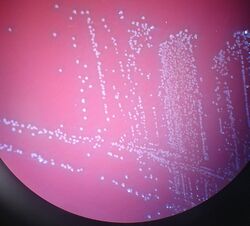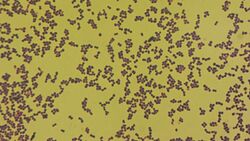Biology:Aerococcus urinae
| Aerococcus urinae | |
|---|---|

| |
| Aerococcus urinae on blood agar[1] | |

| |
| Microscopy of Aerococcus urinae with gram stain, showing gram positive cocci.[1] | |
| Scientific classification | |
| Domain: | |
| Phylum: | |
| Class: | |
| Order: | Lactobacillales
|
| Family: | |
| Genus: | |
| Species: | A. urinae
|
| Binomial name | |
| Aerococcus urinae | |
Aerococcus urinae is a Gram-positive bacterium associated with urinary tract infections.
Classification
Aerococcus urinae is a member of the bacterial genus Aerococcus. The bacterium is a Gram-positive, catalase-negative coccus growing in clusters. Isolates of this genus were originally isolated in 1953 from samples collected in the air and dust of occupied rooms and were distinguished by their tetrad cellular arrangements.[2] Later, it was found in the urine of patients with urinary tract infections[3] and in 1992, A. urinae was assigned as distinct species.[4] Due to difficulties in the biochemical identification of A. urinae in clinical microbiological laboratories, the incidence of infections with this bacterium has likely been underestimated and secure identification relies on genetic techniques like 16S ribosomal subunit sequencing or mass spectroscopic methods such as MALDI-TOF.[5]
Clinical relevance
A. urinae may also cause invasive infections including sepsis originating from the urinary tract and infective endocarditis, especially in elderly men with underlying urinary tract diseases.[6][7]
A. urinae is sensitive to many commonly used antibiotics such as penicillins, cephalosporins, and vancomycin. Nitrofurantoin has been reported to be effective in one series of 42 clinical isolates.[8] The bacterium can form biofilms on foreign materials and can aggregate human platelets, two features of potential importance for the disease causing capacity of this organism.[9]
A. urinae is the most common aerococcus isolated from invasive human infections whereas Aerococcus sanguinicola is isolated from human urine as often as A. urinae.[10]
References
- ↑ 1.0 1.1 Mattila, Jonatan; Häggström, Mikael (2015). "Images of Aerococcus urinae". WikiJournal of Medicine 2 (1). doi:10.15347/wjm/2015.001.
- ↑ Williams, R. E. O.; Hirch, A.; Cowan, S. T. (1953-06-01). "Aerococcus, a New Bacterial Genus". Journal of General Microbiology 8 (3): 475–480. doi:10.1099/00221287-8-3-475. PMID 13061751.
- ↑ Christensen, JJ; Vibits, H; Ursing, J; Korner, B (May 1991). "Aerococcus-like organism, a newly recognized potential urinary tract pathogen.". Journal of Clinical Microbiology 29 (5): 1049–53. doi:10.1128/jcm.29.5.1049-1053.1991. PMID 2056040.
- ↑ Aguirre, M.; Collins, M. D. (1 February 1992). "Phylogenetic analysis of some Aerococcus-like organisms from urinary tract infections: description of Aerococcus urinae sp. nov.". Journal of General Microbiology 138 (2): 401–405. doi:10.1099/00221287-138-2-401. PMID 1373437.
- ↑ Rasmussen, M (December 2012). "Aerococci and aerococcal infections.". Journal of Infection 66 (6): 467–74. doi:10.1016/j.jinf.2012.12.006. PMID 23277106.
- ↑ Ebnöther, C; Altwegg, M; Gottschalk, J; Seebach, JD; Kronenberg, A (Oct 2002). "Aerococcus urinae endocarditis: case report and review of the literature.". Infection 30 (5): 310–3. doi:10.1007/s15010-002-3106-x. PMID 12382093. https://boris.unibe.ch/139173/.
- ↑ Senneby, E; Petersson, A-C; Rasmussen, M (June 2012). "Clinical and microbiological features of bacteremia with Aerococcus urinae.". Clinical Microbiology and Infection 18 (6): 546–50. doi:10.1111/j.1469-0691.2011.03609.x. PMID 21895858.
- ↑ Schuur, P. M. H.; Kasteren, M. E. E. v; Sabbe, L.; Vos, M. C.; Janssens, M. M. P. C.; Buiting, A. G. M. (1997-12-01). "Urinary tract infections with Aerococcus urinae in the South of the Netherlands" (in en). European Journal of Clinical Microbiology and Infectious Diseases 16 (12): 871–875. doi:10.1007/BF01700552. ISSN 0934-9723. PMID 9495666.
- ↑ Shannon, O; Mörgelin, M; Rasmussen, M (Oct 2010). "Platelet activation and biofilm formation by Aerococcus urinae, an endocarditis-causing pathogen.". Infection and Immunity 78 (10): 4268–75. doi:10.1128/IAI.00469-10. PMID 20696834.
- ↑ Senneby, E; Petersson, A-C; Rasmussen, M (Nov 2014). "Epidemiology and antibiotic susceptibility of aerococci in urinary cultures..". Diagn Microbiol Infect Dis. 81 (2): 149–151. doi:10.1016/j.diagmicrobio.2014.11.009. PMID 25497460.
External links
Wikidata ☰ Q4688227 entry
 |

